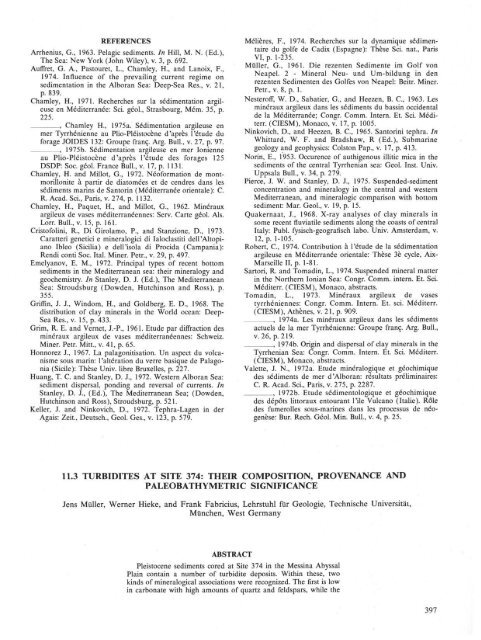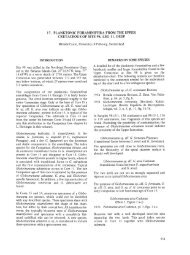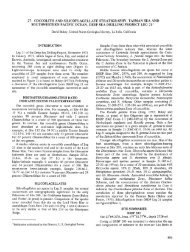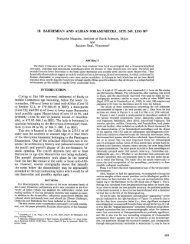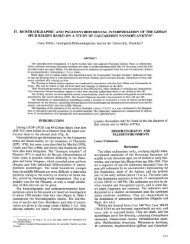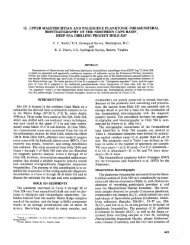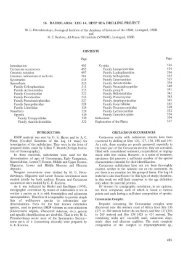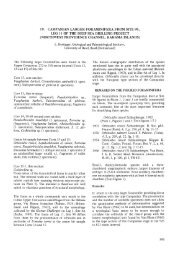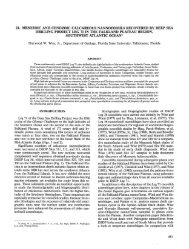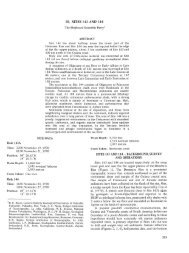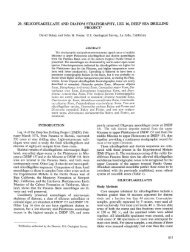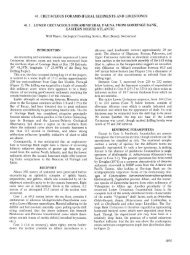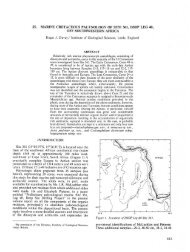Deep Sea Drilling Project Initial Reports Volume 42, Part 1
Deep Sea Drilling Project Initial Reports Volume 42, Part 1
Deep Sea Drilling Project Initial Reports Volume 42, Part 1
You also want an ePaper? Increase the reach of your titles
YUMPU automatically turns print PDFs into web optimized ePapers that Google loves.
REFERENCES<br />
Arrhenius, G., 1963. Pelagic sediments. In Hill, M. N. (Ed.),<br />
The <strong>Sea</strong>: New York (John Wiley), v. 3, p. 692.<br />
Auffret, G. A., Pastouret, L., Chamley, H., and Lanoix, F.,<br />
1974. Influence of the prevailing current regime on<br />
sedimentation in the Alboran <strong>Sea</strong>: <strong>Deep</strong>-<strong>Sea</strong> Res., v. 21,<br />
p. 839.<br />
Chamley, H., 1971. Recherches sur la sedimentation argileuse<br />
en Méditerranée: Sci. géol., Strasbourg, Mém. 35, p.<br />
225.<br />
, Chamley H., 1975a. Sedimentation argileuse en<br />
mer Tyrrhénienne au Plio-Pléistocène d'après Pétude du<br />
forage JOIDES 132: Groupe franc. Arg. Bull, v. 27, p. 97.<br />
, 1975b. Sedimentation argileuse en mer Ionienne<br />
au Plio-Pléistocène d'après 1'étude des forages 125<br />
DSDP: Soc. géol. France Bull., v. 17, p. 1131.<br />
Chamley, H. and Millot, G., 1972. Néoformation de montmorillonite<br />
à partir de diatomées et de cendres dans les<br />
sediments marins de Santorin (Méditerranée orientale): C.<br />
R. Acad. Sci., Paris, v. 274, p. 1132.<br />
Chamley, H., Paquet, H., and Millot, G., 1962. Minéraux<br />
argileux de vases méditerranéennes: Serv. Carte géol. Als.<br />
Lorr. Bull., v. 15, p. 161.<br />
Cristofolini, R., Di Girolamo, P., and Stanzione, D., 1973.<br />
Caratteri genetici e mineralogici di Ialoclastiti delFAltopiano<br />
Ibleo (Sicilia) e dell'isola di Procida (Campania):<br />
Rendi conti Soc. Ital. Miner. Petr., v. 29, p. 497.<br />
Emelyanov, E. M., 1972. Principal types of recent bottom<br />
sediments in the Mediterranean sea: their mineralogy and<br />
geochemistry. In Stanley, D. J. (Ed.), The Mediterranean<br />
<strong>Sea</strong>: Stroudsburg (Dowden, Hutchinson and Ross), p.<br />
355.<br />
Griffin, J. J., Windom, H., and Goldberg, E. D., 1968. The<br />
distribution of clay minerals in the World ocean: <strong>Deep</strong>-<br />
<strong>Sea</strong> Res., v. 15, p. 433.<br />
Grim, R. E. and Vernet, J.-P., 1961. Etude par diffraction des<br />
minéraux argileux de vases méditerranéennes: Schweiz.<br />
Miner. Petr. Mitt., v. 41, p. 65.<br />
Honnorez J., 1967. La palagonitisation. Un aspect du volcanisme<br />
sous marin: 1'alteration du verre basique de Palagonia<br />
(Sicile): These Univ. libre Bruxelles, p. 227.<br />
Huang, T. C. and Stanley, D. J., 1972. Western Alboran <strong>Sea</strong>:<br />
sediment dispersal, ponding and reversal of currents. In<br />
Stanley, D. J., (Ed.), The Mediterranean <strong>Sea</strong>; (Dowden,<br />
Hutchinson and Ross), Stroudsburg, p. 521.<br />
Keller, J. and Ninkovich, D., 1972. Tephra-Lagen in der<br />
Agais: Zeit., Deutsch., Geol. Ges., v. 123, p. 579.<br />
Mélières, F., 1974. Recherches sur la dynamique sédimentaire<br />
du golfe de Cadix (Espagne): These Sci. nat., Paris<br />
VI, p. 1-235.<br />
Müller, G., 1961. Die rezenten Sedimente im Golf von<br />
Neapel. 2 - Mineral Neu- und Um-bildung in den<br />
rezenten Sedimenten des Golfes von Neapel: Beitr. Miner.<br />
Petr., v. 8, p. 1.<br />
Nesteroff, W. D., Sabatier, G., and Heezen, B. C, 1963. Les<br />
minéraux argileux dans les sediments du bassin occidental<br />
de la Méditerranée; Congr. Comm. Intern. Et. Sci. Méditerr.<br />
(CIESM), Monaco, v. 17, p. 1005.<br />
Ninkovich, D., and Heezen, B. C, 1965. Santorini tephra. In<br />
Whittard, W. F. and Bradshaw, R (Ed.), Submarine<br />
geology and geophysics: Colston Pap., v. 17, p. 413.<br />
Norin, E., 1953. Occurence of authigenous illitic mica in the<br />
sediments of the central Tyrrhenian sea: Geol. Inst. Univ.<br />
Uppsala Bull., v. 34, p. 279.<br />
Pierce, J. W. and Stanley, D. J., 1975. Suspended-sediment<br />
concentration and mineralogy in the central and western<br />
Mediterranean, and mineralogic comparison with bottom<br />
sediment: Mar. Geol., v. 19, p. 15.<br />
Quakernaat, J., 1968. X-ray analyses of clay minerals in<br />
some recent fluviatile sediments along the coasts of central<br />
Italy: Publ. fysisch-geografisch labo. Univ. Amsterdam, v.<br />
12, p. 1-105.<br />
Robert, C, 1974. Contribution à l'étude de la sedimentation<br />
argileuse en Méditerranée orientale: These 3è cycle, Aix-<br />
Marseille II, p. 1-81.<br />
Sartori, R. and Tomadin, L., 1974. Suspended mineral matter<br />
in the Northern Ionian <strong>Sea</strong>: Congr. Comm. intern. Et. Sci.<br />
Méditerr. (CIESM), Monaco, abstracts.<br />
Tomadin, L., 1973. Minéraux argileux de vases<br />
tyrrhéniennes: Congr. Comm. Intern. Et. sci. Méditerr.<br />
(CIESM), Athènes, v. 21, p. 909.<br />
, 1974a. Les minéraux argileux dans les sediments<br />
actuels de la mer Tyrrhénienne: Groupe franc. Arg. Bull.,<br />
v. 26, p. 219.<br />
_, 1974b. Origin and dispersal of clay minerals in the<br />
Tyrrhenian <strong>Sea</strong>: Congr. Comm. Intern. Et. Sci. Méditerr.<br />
(CIESM), Monaco, abstracts.<br />
Valette, J. N., 1972a. Etude minéralogique et géochimique<br />
des sediments de mer d'Alboran: résultats préliminaires:<br />
C. R. Acad. Sci., Paris, v. 275, p. 2287.<br />
, 1972b. Etude sédimentologique et géochimique<br />
des depots littoraux entourant File Vulcano (Italie). Role<br />
des fumerolles sous-marines dans les processus de néogenèse:<br />
Bur. Rech. Géol. Min. Bull, v. 4, p. 25.<br />
11.3 TURBIDITES AT SITE 374: THEIR COMPOSITION, PROVENANCE AND<br />
PALEOBATHYMETRIC SIGNIFICANCE<br />
Jens Müller, Werner Hieke, and Frank Fabricius, Lehrstuhl für Geologie, Technische Universitai,<br />
München, West Germany<br />
ABSTRACT<br />
Pleistocene sediments cored at Site 374 in the Messina Abyssal<br />
Plain contain a number of turbidite deposits. Within these, two<br />
kinds of mineralogical associations were recognized. The first is low<br />
in carbonate with high amounts of quartz and feldspars, while the<br />
397
J. MULLER, W. HIEKE, F. FABRICIUS<br />
INTRODUCTION<br />
other is characterized by high amounts of aragonite and Mg-calcite<br />
derived from shallow-water environments. The second association<br />
is identical with that of turbidites deposited in the Messina Abyssal<br />
Plain in the Holocene. A North-African source area is assumed<br />
from present-day circum-Ionian carbonate distribution.<br />
Absence of turbidite layers within Pliocene sediments and the<br />
low sedimentation rate during this period indicate that the basin<br />
morphology did not allow turbidite deposition before the Pleistocene.<br />
This is interpreted as an argument for Plio-Pleistocene<br />
subsidence of the Ionian basin.<br />
Textural and compositional analyses of turbidite<br />
sequences may provide clues for the determination of<br />
their provenance; their stratigraphic position may help<br />
to decipher the paleobathymetric development (and<br />
tectonic evolution) of their depositional basins.<br />
In the light of existing controversy as to the paleobathymetry<br />
of the Mediterranean area during the<br />
Miocene (Ryan, Hsü, et al., 1973; Drooger, 1973), the<br />
stratigraphic distribution of turbidites in the Plio-<br />
Quaternary sediment sequence is of great interest.<br />
Site 374 was drilled in the central part of the<br />
present-day Messina Abyssal Plain (35° 50.87' N, 18°<br />
11.78' E; water depth 4078 m corrected echo sounding).<br />
The thickness of post-Messinian sediments at this<br />
site is approximately 360 meters and the Pliocene/<br />
Pleistocene boundary is at a depth of about 300<br />
meters.<br />
Within the extremely short sections cored within the<br />
Pleistocene sediments a number of layers with graded<br />
bedding and/or laminations were described which<br />
could be related to turbiditic sedimentation.<br />
Samples from these sequences were analysed for<br />
their texture as well as their faunal and mineralogical<br />
composition (Figure 1).<br />
RESULTS AND DISCUSSION<br />
Within the Pleistocene turbidites recognized so far<br />
two kinds of mineralogical associations were found:<br />
1) the first association, found in Core 4, Sections 3<br />
and 4, is characterized by a comparatively high content<br />
of quartz, k-felspar, and plagioclase while calcite and<br />
dolomite are less abundant. Total carbonate does not<br />
exceed 30 percent within the samples analyzed. Mean<br />
size varies between 6.3 Φ and 8.3 Φ; the sand content<br />
ranges from 8 to 1 percent, silt from 80 to 34 percent,<br />
and clay from 64 to 12 percent. The sand fraction<br />
consists mainly of benthonic and planktonic foraminifera<br />
and less abundant echinoid spines, siliceous sponge<br />
spicules in addition to unspecified shell material, mica<br />
and quartz.<br />
2) the second association was encountered within<br />
Cores 1, in the core catchers of Cores 2 and 4, and in<br />
Core 5, Section 1. Its prominent feature is the presence<br />
of the carbonate minerals: aragonite (up to 24%) and<br />
Mg-calcite (up to 18%) along with varying amounts of<br />
calcite and dolomite. Total carbonate ranges between<br />
29 and 53 percent. Also frequent are quartz, microcline<br />
and albite. The clay fraction is composed of smectite,<br />
chlorite, kaolinite, illite, mixed-layers (only subordinate),<br />
and in some instances attapulgite. A common,<br />
398<br />
but only minor component is hornblende. Mean size<br />
ranges from 5.1 Φ to 9 Φ. Sand varies between 0 and<br />
41 percent, silt from 38 to 79 percent, and clay from 8<br />
to 59 percent. The sand fraction is composed of benthic<br />
and planktonic foraminifer, pteropods, unspecified<br />
biogenic shell fragments, mica, quartz, and heavy<br />
minerals; subordinate are echinoid debris, skeletal<br />
parts of ophiura and holothurians, siliceous sponge<br />
spicules, and fragments of bryozoa.<br />
While the first association does not contain any<br />
specific components pointing to a specific source area,<br />
the second association clearly indicates provenance<br />
from a shallow-water area. This conclusion is mainly<br />
based on the occurrence and abundance of the metastable<br />
carbonate minerals Mg-calcite and aragonite,<br />
which have also been found in Quaternary turbidites of<br />
the Messina Abyssal Plain. (Milliman and Müller,<br />
1973; Hieke et al., in preparation).<br />
Presently, areas of extensive carbonate productivity<br />
appear to be restricted to the northern African coast as<br />
is indicated by the studies of Caulet (1972); Fabricius<br />
(personal communication); Stoffers (personal communication);<br />
Emelyanov (1972) and Venkatarathnam and<br />
Ryan (1971). Also, identical carbonate mineral associations<br />
have been reported by Chamley (1971) from<br />
the slope off Libya. In constrast, available information<br />
on the carbonate sedimentation at the western, northern<br />
and northeastern border of the Ionian <strong>Sea</strong> is only<br />
scarce and limited to local areas. Preliminary investigations<br />
of Recent shelf sediments off the southern coast<br />
of Calabria and Apulia (Rumohr and Müller, in preparation)<br />
indicate mainly terrigenous deposits there and<br />
Mg-calcite was found only locally and in low concentrations,<br />
while aragonite appears to be very rare. From<br />
the shelf surrounding Cephalonia (Ionian Islands)<br />
Braune (1973) found Mg-calcite enrichments in the<br />
near shore areas as well on the deeper shelf (up to<br />
10%), while aragonite was detected only in minor<br />
concentrations.<br />
If one assumes a similar circum-Ionian pattern of<br />
carbonate sedimentation in the past which resulted in a<br />
comparable carbonate mineral association, a southern<br />
(North-African) source for the Plio-Quaternary turbidites<br />
containing large amounts of Mg-calcite and aragonite<br />
appears most likely. This is supported by the<br />
presence of attapulgite which is abundant in Tertiary<br />
soils from the north-african borderlands (Chamley and<br />
Millot, 1975). As for the non-carbonate fraction of<br />
these turbidites, consisting of quartz, microcline, and<br />
albite (and hornblende), one can assume acidic intrusive<br />
or effusive source rocks. At present no definite<br />
source can be attributed to these minerals; they prob-
DSDP 374<br />
LO , ==<br />
1<br />
2<br />
3<br />
/• >/<br />
— 65-66<br />
— 123-124<br />
— 136-138<br />
^144-146<br />
— 17-19<br />
— 145-147<br />
— cc<br />
TC CA<br />
(%)<br />
MC DO AR<br />
(Φ)<br />
Mz SA<br />
(%)<br />
SI CL<br />
49 10 18 9 12 6.2 - 89 11<br />
40 13 13 9<br />
29 23 2 4<br />
43 23 4 9<br />
46 6 14 19<br />
47<br />
45<br />
9<br />
11<br />
16<br />
17<br />
9<br />
2<br />
13<br />
15<br />
6.5<br />
9.0<br />
6.4<br />
5.1<br />
5. 3<br />
6. 2<br />
15 74 11<br />
3 38 59<br />
15 69 16<br />
32 63 5<br />
41<br />
29<br />
52<br />
43<br />
7<br />
28<br />
—cc 44 14 12 11 6.8 85 13<br />
Figure 1. Synopsis of carbonate mineralogy and grain size<br />
analyses. Core profile after visual core description (shipboard<br />
scientific party). TC = total carbonate, CA =<br />
calcite, MC=Mg-calcite, DO = dolomite, AR = aragonite,<br />
Mz = mean size (Folk), SA = sand, SI = silt, CL = clay,<br />
cc = core catcher.<br />
ably represent an eolian component within the originally<br />
shallow-water sediments.<br />
The Pleistocene sedimentation rate at Site 374 was<br />
about 15 cm/1000 years (Cita et al., this volume). On<br />
DSDP 374<br />
1<br />
2<br />
si<br />
4<br />
t<br />
1<br />
1<br />
-<br />
TC CA MC DO AR<br />
TURBIDITES AT SITE 374<br />
(Φ)<br />
Mz SA SI CL<br />
— — 2-4 22 18 - 8.3 1 56 43<br />
77-79<br />
79-81<br />
95-97<br />
115-116<br />
• 85-86<br />
— CC<br />
31<br />
29<br />
23<br />
21<br />
27 -<br />
27 -<br />
21 -<br />
19 -<br />
4<br />
2<br />
2 -<br />
2<br />
29 23 - 6<br />
32 21 3 4 4<br />
34 11 9 8 6<br />
— 96-97 53 7 1 0 2 24 6.2 19 66 15<br />
— 138-139 51 12 13 8 18 7.6 9 51 40<br />
Figure 1. (Continued).<br />
the Mediterranean Ridge, the sedimentation rate calculated<br />
for that part of the Pleistocene sequence which<br />
can be cored by piston cores (maximum length about<br />
16 m) is dependent on differing chronological interpretations<br />
of the climatic curves. They vary between 2.4<br />
cm/1000 years (Cita et al., in press) and about 6 cm/<br />
1000 years (e.g., Hieke, 1976). In either case, the<br />
sedimentation rate at Site 374 is much higher than in<br />
the adjacent ridge area. If one assumes that the cored<br />
sections of Site 374 are representative of the whole<br />
Quaternary sequence, the thickness and occurrence of<br />
the clearly recognizable turbidite layers within Cores 1<br />
to 5 are not sµfficient to explain the huge sedimenta-<br />
6.3<br />
9.1<br />
7.0<br />
8<br />
2<br />
1<br />
80<br />
34<br />
73<br />
12<br />
64<br />
26<br />
399
J. MULLER, W. HIEKE, F. FABRICIUS<br />
tion rate. Therefore, one has to expect that many of the<br />
"homogeneous" nannofossil marls and oozes of the<br />
cored Pleistocene sections of this site are in fact finegrained<br />
turbidites. For example, a 12-meter-thick interval<br />
of sediment younger than 9000 years is interpreted<br />
as a single turbidite layer and has been found in<br />
several piston cores from the Messina Abyssal Plain<br />
(Hieke et al., in preparation). This turbidite layer<br />
contains about 11 meters of "homogeneous" silty clay.<br />
For the Pliocene sediments at Site 374 which were<br />
cored continuously, no indication of turbidite deposition<br />
was noted by the shipboard party. Also, no distinct<br />
lithologic changes were observed in our X-ray analysis<br />
(Müller, this volume). Therefore, it can be concluded,<br />
that turbidites played no great role in sedimentation<br />
during the Pliocene. This may be supported by the low<br />
sedimentation rates as calculated for this interval: 1.3<br />
cm/1000 years for the lower Pliocene, 5.0 cm/1000<br />
years for the upper Pliocene (Cita et al., this volume).<br />
CONCLUSIONS<br />
Site 374 Pliocene sedimentation was more or less<br />
free of turbidites which contrasts strongly with a<br />
Quaternary turbidite sedimentation. Several factors<br />
have been proposed to explain this sharp contrast: (1)<br />
changes of the morphology of the Ionian <strong>Sea</strong> and the<br />
surrounding mainland (uplift or subsidence); (2) Quaternary<br />
uplift of Calabria (Hsü, personal communication);<br />
(3) conditions related to entrapment of sediment<br />
following a sudden early Pliocene flooding of a desiccated<br />
Mediterranean (Cita et al., this volume).<br />
The "deep-basin desiccation model" assumes a<br />
more or less comparable bathymetry to the present one<br />
for the Miocene (Ryan, Hsü, et al., 1973) and with<br />
respect to this the lack of turbidites in the Pliocene<br />
sequence is surprising and difficult to explain. We<br />
think, that desiccation of the shallow coast and of parts<br />
of the upper slope during the Miocene evaporation<br />
periods should produce conditions for weathering and<br />
subsequent erosion after the refill of the basin at the<br />
beginning of the Pliocene. Cita et al. (this volume)<br />
suggest that entrapment of coarse clastic sediments<br />
occurred in estuaries after the early Pliocene submergence<br />
of the Messinian valleys and therefore there was<br />
no transport of material for turbiditic sedimentation on<br />
the Messina Abyssal Plain. We are neither aware of<br />
the presence of these postulated Messinian valleys<br />
within the circum-Ionian area nor have relicts of<br />
Pliocene estuaries been found to our knowledge, where<br />
such entrapment of coarse sediment material could<br />
have occurred. Also, the predominant type of mineral<br />
association present within the Pleistocene turbidites did<br />
not come from Pliocene estuarine environments nor<br />
represents land-derived clastic material but rather<br />
came from shallow shelfs or platforms with prevailing<br />
biogenic carbonate production.<br />
Finally, the uplift of Calabria and/or Sicily since the<br />
Plio-Pleistocene boundary is not responsible for the<br />
onset of the dominant carbonate turbidite sedimenta-<br />
400<br />
tion in the Messina Abyssal Plain, since the Pliocene<br />
sediments of these areas do not contain carbonate<br />
mineral associations such as found in the turbidites.<br />
Therefore, the observed change in the sedimentation<br />
regime appears more compatible with the assumption<br />
of a "shallow-basin" during the Miocene. We believe<br />
that more or less continuous subsidence of the Ionian<br />
basin (and concomittant uplift of adjacent areas)<br />
finally led to the present-day basin configuration.<br />
Apparently only near the Plio/Pleistocene boundary<br />
was the necessary morphology existent in the Messina<br />
Abyssal Plain for the onset of turbidite deposition.<br />
ACKNOWLEDGMENTS<br />
This investigation is a part of the sedimentological survey<br />
of DSDP material financed by the Deutsche Forschungsgemeinschaft.<br />
We thank our colleagues Drs. K. Braune and W.<br />
Sigl for discussions and Dr. R. B. Kidd for a critical review of<br />
the manuscript.<br />
REFERENCES<br />
Braune, K., 1973. Die rezenten und pleistozanen Sedimente<br />
des Sublitorals von Kephallinia (Ionische Inseln): Senckenbergiana<br />
marittima, v. 5, p. 99-133.<br />
Caulet, J., 1972. Les sediments organogènes du précontinent<br />
algérien: Mém. Museum National d'Histoire Naturelle,<br />
Nouv. Sér., C, v. XXV, p 289.<br />
Chamley, H., 1971. Recherches sur la sedimentation argileuse<br />
en Méditerranée: These Université Marseille, p. 401.<br />
Chamley, H. and Millot, G., 1975. Observations sur la<br />
repartition et la genèse des attapulgites plio-quaternaires<br />
de Méditerranée: C. R. Acad. Sci., Paris, Sér. D, v. 81, p.<br />
1215-1218.<br />
Cita, M., Vergnaud-Grazzini, C, Robert C. Chamley, H.<br />
Ciaranfi, N., and d'Onofrio, S., in press. Paleoclimatic<br />
record of a long deep-sea core from the eastern Mediterranean:<br />
Quaternary Research.<br />
Drooger, C, (Ed), 1973. Messinian events in the Mediterranean.<br />
Geodynamics Scientific Report No. 7 on the colloquim<br />
held in Utrecht, March 2-4, 1973: North-Holland<br />
Publishing Company, p 272.<br />
Emelyanov, E., 1972. Principal types of recent bottom<br />
sediments in the Mediterranean <strong>Sea</strong>: their mineralogy and<br />
geochemistry. In Stanley, D. J. (Ed.), The Mediterranean<br />
<strong>Sea</strong>: Dowden, Hutchinson & Ross, p. 355-386.<br />
Hieke, W., 1976. Problems of eastern Mediterranean late<br />
Quaternary stratigraphy - a critical evaluation of literature:<br />
Meteor Forschungs-Ergebnisse, v. 24, p. 68-88.<br />
Hieke, W., Melguen, M., and Fabricius, F., in preparation.<br />
Turbidites from the Messina Abyssal Plain and the<br />
Mediterranean Ridge - possible indications of young<br />
tectonics.<br />
Milliman, J. and Müller, J., 1973. Precipitation and lithification<br />
of magnesian calcite in the deep-sea sediments of the<br />
eastern Mediterranean <strong>Sea</strong>: Sedimentology, v. 20, p. 29-<br />
45.<br />
Ryan, W. B. F., Hsü, K. J., et al., 1973. <strong>Initial</strong> reports of the<br />
<strong>Deep</strong> <strong>Sea</strong> <strong>Drilling</strong> <strong>Project</strong>, <strong>Volume</strong> 13: Washington (U.S.<br />
Government Printing Office).<br />
Venkatarathnam, K. and Ryan, W. B. F., 1971. Dispersal<br />
patterns of clay minerals in the sediments of the eastern<br />
Mediterranean <strong>Sea</strong>: Marine Geology, v. 11, p. 261-282.


